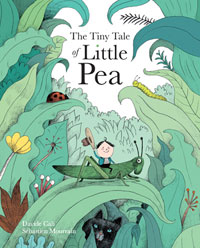| ________________
CM . . .
. Volume XXIV Number 23. . . .February 16, 2018

 |
The Tiny Tale of Little Pea.
Davide Cali. Illustrated by Sébastien Mourrain.
Toronto, ON: Kids Can Press, 2017.
36 pp., hardcover, $18.99.
ISBN 978-1-77138-843-6.
Preschool-grade 1 / Ages 4-6.
Review by Sabrina Wong.
***˝ /4
|
| |
|

excerpt:
When he was born, Little Pea was tiny. Teeny-tiny.
Davide Cali and Sébastien Mourrain’s The Tiny Tale of Little Pea is a sweet story that celebrates each person’s uniqueness. The protagonist, Little Pea, struggles with being tiny in a large world. At school, because Little Pea is too small to play with the other children, he spends his time drawing. When Little Pea grows older, he discovers the perfect job for his small stature and artistic talents.
Cali’s prose is lively and energetic. The writing engages the reader in telling the story: “And do you know what Little Pea’s job is? You’ll never guess!” (p. 27). His conversation-like use of shorter sentences makes The Tiny Tale of Little Pea a great read-aloud. Readers may recognize Cali’s style from his earlier picture book, The Enemy (2009). However, The Tiny Tale of Little Pea is more suited to younger readers with its lighthearted tone and uplifting message. Little Pea is a fun character with charming quirks and hobbies.
Mourrain’s illustrations pair well with the personality of Little Pea; they are fanciful, adorable, and fun. Via Mourrain’s skillful use of pencil sketching and digital colouring, Little Pea inhabits a whimsical world. Mourrain mostly uses a soft palette of greens and blues, with bright pops of yellow and red. The use of pencil crayon makes the lines soft and gives the illustrations an overall appearance of gentleness. Each illustration is a tiny artwork in itself, with interesting use of perspective through Little Pea’s eyes. Young readers will enjoy picking out everyday objects re-imagined into Little Pea’s tiny landscape. Two playing cards and a binder clip become an artist’s easel. A stack of lego bricks becomes a climbing wall. Tomato plants become tall trees. It is a pleasure to see the delights each page depicts.
It appears that Cali and Mourrain collaborated closely on the text and illustrations; on page 5, the upper half of the page has the text, “His bed?”, paired with an illustration of Little Pea sleeping in a matchbox bed, and the lower half shows Little Pea snoozing on his cat, “It depended.” The Tiny Tale of Little Pea’s success is owed to this great partnership: Cali’s writing and Mourrain’s illustrations are a perfect sassy pair. There is also a visual progression that matches the story’s three-part structure: in the first section where Little Pea lives a wild and carefree life, the pages explode with colour and detail; in the middle section, Little Pea’s social isolation is shown with a more somber grayscale surroundings and people; in the final section where Little Pea comes into his own, the colours and details from the first section re-emerge.
The Tiny Tale of Little Pea would be a valuable addition to any library. It encourages young readers to embrace their differences and recognize that they, too, have a special place in the world.
Note: The Tiny Tale of Little Pea was originally published in French as Petit Pois (2016).
Highly Recommended.
Sabrina Wong is the Teaching and Outreach Librarian at Capilano University in North Vancouver, BC.

© CM Association
CC BY-NC-ND
Hosted by:
University of Manitoba
ISSN 1201-9364
|
This Creative Commons license allows you to download the review and share it with others as long as you credit the CM Association. You cannot change the review in any way or use it commercially.
Commercial use is available through a contract with the CM Association. This Creative Commons license allows publishers whose works are being reviewed to download and share said CM reviews provided you credit the CM Association. |
Next Review | Table of Contents for This Issue - February 16, 2018.
CM Home | Back Issues | Search | CM Archive | Profiles Archive
|
